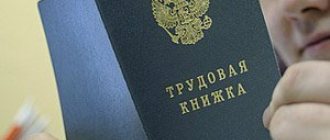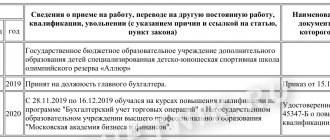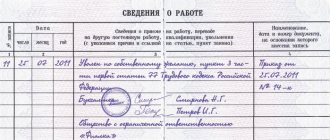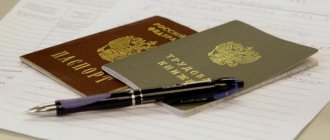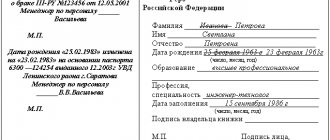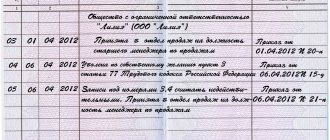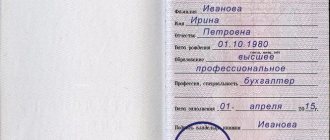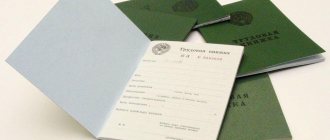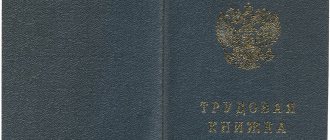The work book is a mandatory personnel document, the history of which goes back more than 80 years. Despite the fact that currently the work record book is no longer playing its former role when applying for a pension, it continues to remain one of the most important personal documents of Russian citizens. It is no coincidence that a work book is called a citizen’s “second passport,” certifying his professional experience, qualifications, and achievements in work. But unlike a passport, the work book does not contain a photograph, which means that all the information indicated on the title page of this document acquires special significance.
The Labor Code of the Russian Federation calls the work book the main document about the employee’s work activity and length of service (Part 1 of Article 66 of the Labor Code of the Russian Federation). Without a work record, it would be quite difficult to solve the problem of selecting applicants for a position, it is no coincidence that in Part 1 of Art. 65 of the Labor Code of the Russian Federation, it is indicated as the second document after the passport or other identification document presented when concluding an employment contract.
Work with work books is regulated by the norms of the Labor Code of the Russian Federation, as well as by-laws adopted by the Government of the Russian Federation and federal executive authorities. For example:
1. Decree of the Government of the Russian Federation dated April 16, 2003 No. 225 “On work books”, which approved:
- new forms of the work book and insert in the work book, put into effect from 01/01/2004;
- Rules for maintaining and storing work books, producing work book forms and providing them to employers (hereinafter referred to as the Rules).
The said resolution states that the previously established work books (1938 and 1973) available to employees are valid and cannot be exchanged for new ones.
2. Resolution of the Ministry of Labor of Russia dated October 10, 2003 No. 69, which approved:
- Instructions for filling out work books (hereinafter referred to as the Instructions);
- form of the receipt and expenditure book for recording the forms of the work book and the insert in it;
- form of a book for recording the movement of work books and inserts in them.
3. Order of the Ministry of Finance of Russia dated December 22, 2003 No. 117n “On work books”, which approved:
- samples of the work book and its insert;
- The procedure for providing employers with work book forms and an insert in the work book.
Difficult situations arise when registering a work book for the first time, as well as a new work book if it is necessary to change or correct any information on its title page. The main problems with maintaining work books include: the presence of work books by employees that are not drawn up on forms of the established form or on forms that are no longer used because they have been replaced by new ones; discrepancy between the employee’s personal data on the title page of the work book and his data in the passport; lack of a seal imprint on the title page of the work book, etc. In this article we will look at some such situations and tell you how to proceed.
Legislative regulation of filling out a work book
When filling out a work book regarding education, the employer must take into account the following provisions of the law:
- Art. 65, 66 Labor Code ;
- Part 4, 5 Art. 10, part 1, 6, 7, 9 art. 60 273-FZ ;
- pp. “6” clause 9 of the Rules approved by Government Decree No. 225 ;
- clause 2.1 of the Ministry of Labor Instructions No. 69 on filling out work books.
Information about the employee’s education is on the title page of the work book after his last name, first name, and patronymic.
Education information is entered into the work book by a HR specialist based on the document provided by the employee. Errors made on the title page of the work book, which contains a record of education, can make it invalid.
If a mistake was made when filling out a new work record book, then the employer should cancel the form and draw up a report about it and issue the employee a new work record book with the correct record of the level of education.
If the employer does not record education in the work book based on the documents provided, then he is violating the law. In this case, it is possible to hold him accountable under Art. 5.27 Code of Administrative Offenses of the Russian Federation.
At the same time, it is believed that failure to make an entry, provided that the work does not require special knowledge and skills from the employee, is not a violation of the law, since it does not infringe on his rights. But during the inspection, the labor inspector may require the employer to write down the specified information in the work book.
Levels of education in the Russian Federation
According to Article 10 of the Federal Law “On Education in the Russian Federation”, N273-FZ
In Russia there are the following types and levels of general education:
- preschool;
- initial general;
- basic general;
- average overall.
The following levels of vocational education are established in the Russian Federation:
- secondary vocational (vocational school, college, etc.);
- higher - bachelor's degree;
- higher - specialty, master's degree;
- higher education - training of highly qualified personnel.
https://youtu.be/EAkWvCdCRxk
Basis for entering a mark on education
According to Instruction No. 69 of 2003, Art. 2.1, the educational mark is entered on the basis of:
- Original diploma.
- Its certified copy.
A record of a completed educational stage can be made on the basis of a grade book, student card or copies thereof. But it is strictly forbidden to make a note about education based on the employee’s oral evidence.
As noted, a record of education is made on the basis of one of the duly certified documents received at the educational institution. Such a document can be:
- Certificate of basic general education – basic general education.
- Certificate of secondary general education – general secondary education.
- Diploma of secondary vocational education – vocational (secondary).
- Bachelor's degree - higher education with a bachelor's degree.
- Specialist diploma – higher with a specialist degree.
- Master's degree - higher education with a master's degree.
- Diploma of completion of postgraduate study , postgraduate study, residency, assistantship-internship, diploma of candidate of sciences.
It is worth considering that modern education should be indicated along with its level (specialist or bachelor). Recent changes in legislation are not a basis for correcting the entry on higher education in the work book (meaning the allocation of new levels of education), in particular, in order to make new or additional entries in this document.
The employer does not need to check the authenticity of the diploma provided by the employee. This is not his responsibility. But the employer should make a copy of the employee’s education document provided so that there are no problems with regulatory authorities.
When an applicant for a position is still continuing his studies, it is allowed not to include anything in the education column and this will not constitute a violation.
But it is also possible to enter a record of incomplete education in this column . For example, “incomplete secondary vocational”, “incomplete higher-bachelor’s degree”. Such an entry is made in the work book at the request of the employee upon presentation of a student card, grade book or certificate from an educational organization about training.
Until 2007, students were issued diplomas of incomplete higher education, provided that they managed to study for at least 2 years (according to paragraph 3 of Article 6 of Federal Law No. 125, which has become invalid). If the employee brought such a diploma, then despite the fact that now the concept of “incomplete higher education” does not exist, then in the work book you can still make the entry “incomplete higher education” in the “education” column.
After all, the entry is made in accordance with the document that confirms the training, so the employer will follow the requirements of the law.
Key Points
The document is divided into specific sections:
- title page;
- information about work;
- information about awards.
We suggest you familiarize yourself with: How an apartment is divided during a divorce if the owner is a husband.
The first page contains the person’s personal data, and on other pages there are records recorded in the labor process:
- FULL NAME;
- date, month, year of birth;
- information about education;
- profession, specialty.
- recruitment;
- dismissal;
- awards.
All data is confirmed by the signature of the employer or authorized employee and the seal of the company.
How to make a mark
An empty line in the work book form is filled in on the basis of a properly executed document in the following cases:
- It was not filled out by the previous employer.
- An employee gets a job for the first time in his life.
When filling out a work book, there are certain rules that apply to the method of entering information into it. Various corrections, crossing out and covering up are strictly prohibited.
Entries in the work book are made by hand, typesetting is not used. To write notes, the employer should use black or blue ink and preferably a ballpoint pen. Abbreviations on the title page are not allowed.
Information about education is entered into the employment record strictly according to the document provided by the employee. If an employee brought a diploma that was received before the reform of the education system, then the level of education according to the diploma is recorded in the work book. For example, “higher professional”. This rule applies even if that level of education has been abolished and is no longer valid.
Since 2013, records of higher education are written with a dash as “higher education-bachelor’s degree”, “higher education-master’s degree”, “higher education-specialist”. You do not need to enter details of your education document into your employment record.
In some cases, information about training is entered in the “Work Information” section. This is necessary if the employee completed his studies at an educational institution during the period of employment with the employer under consideration. For example, received a second higher education, completed training courses or at a school for advanced training, at a school for retraining personnel.
As a result of such training, an employee could receive a second and subsequent profession, specialty, class, category or rank. The basis for making such entries may be the same documents as on the title page of the work book. This is, for example, a certificate of profession of a worker or employee (based on the results of advanced training during vocational training), a certificate of advanced training, etc.
The procedure for filling out an educational record in the work section is established in paragraph 3.1 of Instruction No. 69, paragraphs. “b” clause 21 of Rules No. 225:
- Column 1 contains the serial number of the entry.
- In column 2, the date of issue of the document conferring a new profession, specialty or qualification, the date of making the entry (i.e., the day the employee brought the documents) - when the employee undergoes retraining or advanced training courses.
- Column 3 indicates the name of the specialty (for example, the profession “electrician with the assignment of 3rd category” is established) or the place of retraining and the period of retraining.
- Column 4 contains the name, date and number of the document on education, training and qualifications.
Information about the profession and specialty is also entered on the basis of the employee’s diploma. Employers often make mistakes in this line. For example, the diploma indicates the qualification “economist” with a specialty in “finance and credit”. In the line with the profession you need to write down exactly “finance and credit”.
Although Rostrud believes that indicating qualifications instead of specialty will not be considered a gross violation and cannot be corrected.
The education section in the work book does not need to be filled out in the following cases:
- If the employee has received only primary training of grade 3.
- If the employee did not provide a document that would confirm the level of his qualifications.
- If the employee is a student and does not insist on making a record of incomplete education.
A sample record of education in a work book can be viewed here.
Job details
Job information may indicate obtaining a second education or advanced training. All entries are made only on the basis of relevant documents. The line is assigned a serial number, then the date written in the education document is indicated, then information about the new profession, qualifications, etc., at the end the details of the educational document and the date of its provision are written down.
This is especially important for those workers whose profession requires special training or knowledge. Moreover, in this case, the employer may be held administratively liable for the lack of this information. For representatives of blue-collar professions, such data can be entered at will.
General information about changes
When entering and correcting information, you cannot make a mistake in the work book. There are clear instructions for such actions, which are given in the Rules for maintaining and storing the Labor Code of 2003 (hereinafter referred to as the Rules) and in the Instructions for filling out the Labor Code of 2003 (hereinafter referred to as the Instructions).
These documents prohibit cleaning, scraping, or covering up changeable data . Strikethroughs are also unacceptable everywhere except the first (title) page of the TC. With a thin line, you can cross out for correction and change only information about the employee on the first page: full name, date of birth, education received, profession and specialty.
At the same time, it is necessary to carefully place relevant information nearby.
Neither red nor green ink, nor pencils should be used when changing entries in the TC: only ballpoint pens in blue shades or black (pens with a gel refill or nib are also not prohibited).
Abbreviating words when recording information in the TC is not allowed.
Secondary vocational education
Many applicants are interested in the differences between what can be acquired in college and education in a college or technical school.
You will learn about all the subtleties from this material. Very often on the Internet you can come across questions from puzzled users:
- Technical school, college or college - what is valued more?
- What is education after technical school called?
- What kind of education is technical school?
- What level of specialist will I become after graduating from college?
- Graduated from technical school.
What kind of education is this? - After graduating from technical school, what kind of education?
The name of the institution, as a rule, does not affect the quality of education.
If a TC with an incorrect education record has already been transferred to another organization, then it is recommended to follow the procedure prescribed in the Instructions for correcting the information on the title page of the TC:
- An erroneous entry is crossed out with a thin single line;
- The type of education noted in the educational document is written next to it;
- The cover references the document provided by giving its title, series and number;
- The link is stamped with the employer who made the adjustment, and signed by the employee responsible for maintaining the technical documentation.
Entry in the work book about a change in education - sample:
Changes and bug fixes
Making changes and additions involves the action of replacing or adding to an entry that was made earlier, without any errors.
By correction we mean an action aimed at replacing a previously made entry, but with any errors.
It is unacceptable to make
typos in entries on the title page , since the truthfulness of information about the worker’s personal data is one of the most important rules for filling out.
As a rule, the likelihood of inaccurate writing or making an error is quite high, because the document is filled out manually .
In general, corrections are made to materials about work and awards.
If an error is made in the line about training, the work book will no longer be genuine it is impossible to edit this entry .
The person filling it out will have to draw up a special act on the destruction of damaged forms, which records the fact that the document is no longer valid .
This act is filed in a special file.
Only on the basis of the above act can a book that has become unusable be destroyed.
All costs for a new employee book are covered by the employer at his own expense .
If an error or error is discovered after 5-10 years of an employee’s work in the company, the head of the enterprise goes to meet the citizen who has been working for so many years.
He crosses out the incorrect inscription entirely (with one line so that the entry remains readable) and enters new reliable data next to the erroneous version.
In order to confirm these actions, the document with which the correct information was entered is indicated on the back cover.
After this, the entry must be certified with a seal and signature .
You can read more about how to make corrections here.
College what kind of education in labor
Information about the dismissal and the reason for the reduction are also indicated.
In addition, a work book is required when applying for a job.
If a person has just graduated from technical school and has not worked officially before, then this document will need to be completely filled out. Information about higher education must be entered, and it must be indicated in a certain way.
Basic Rules
Before making an entry in the work book, you need to familiarize yourself with the basic requirements.
Otherwise, you will either have to draw up a new document or change the information.

